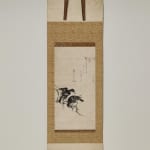Matsuo Bashō (1644−1694)
Crows on a Branch
Ink on paper, hanging scroll
Poem inscribed by the artist
With authentication by Okura Kyusui,
box authentication by Futsukabo Sou (1764), double boxed
Seals: Aki ni taezu, To
53.2 x 26.2 cm
140.5 x 36 cm (overall)
Further images
According to the inscription on the scroll box by Futsukabo So’u (1711–1775), this jigasan was formerly owned by Nishijima Shoho of Iga (the present day Mie prefecture) and later acquired by Matsuda Ransen, both of whom have not been identified. “Jigasan” refers to, in this case, Basho’s haiku calligraphy accompanied by his illustration.
Therefore, in mid-eighteenth century, the present scroll was believed to be both inscribed and painted by Basho. Two works with the same poem inscribed by Basho with unsigned paintings are known; a scroll in the Waseda University Library collection and a tanazaku in the Idemitsu collection. However both collections speculate that their paintings were not painted by Basho, but professional painters.
Basho certainly painted himself. In the Farewell Words for Kyoroku, he wrote that he respected Kyoroku as his teacher of painting. In his letter to a samurai called Nakamura Anshi, he mentioned in a self-mocking manner that his paintings were just like children’s playful works. Among many examples of Basho’s haiku calligraphies with unsigned paintings, only those with a seemingly amateurish painting are regarded as jigasan by Basho, while those skillful ones, such as above-mentioned two, are not recognized as jigasan, but as Basho’s haiku calligraphies with professional paintings. Two birds in the present scroll seem to be done by professional hands, but the brushwork is rather amateurish. The tiny dots on the bough are also observed on a tree depicted in the famous Hand Scroll of Journey by Basho in the Kakimori collection. These features suggest the present work is highly possibly a jigasan by Basho.
Matsuo Basho (haiku poet; 1644−1694)
Also known as Munefusa; Tosei; Hakusendo; Bashoan; etc.
Iga-born mid Edo period haiku poet. First learned the Teimon-ha style of haiku poetry composition after Kitamura Kigin, and later gained inspiration from the Danrin-ha style after moving to Edo. Through numerous travels, Basho set up the Shofu style that had elevated haiku to a form of high art.
Therefore, in mid-eighteenth century, the present scroll was believed to be both inscribed and painted by Basho. Two works with the same poem inscribed by Basho with unsigned paintings are known; a scroll in the Waseda University Library collection and a tanazaku in the Idemitsu collection. However both collections speculate that their paintings were not painted by Basho, but professional painters.
Basho certainly painted himself. In the Farewell Words for Kyoroku, he wrote that he respected Kyoroku as his teacher of painting. In his letter to a samurai called Nakamura Anshi, he mentioned in a self-mocking manner that his paintings were just like children’s playful works. Among many examples of Basho’s haiku calligraphies with unsigned paintings, only those with a seemingly amateurish painting are regarded as jigasan by Basho, while those skillful ones, such as above-mentioned two, are not recognized as jigasan, but as Basho’s haiku calligraphies with professional paintings. Two birds in the present scroll seem to be done by professional hands, but the brushwork is rather amateurish. The tiny dots on the bough are also observed on a tree depicted in the famous Hand Scroll of Journey by Basho in the Kakimori collection. These features suggest the present work is highly possibly a jigasan by Basho.
Matsuo Basho (haiku poet; 1644−1694)
Also known as Munefusa; Tosei; Hakusendo; Bashoan; etc.
Iga-born mid Edo period haiku poet. First learned the Teimon-ha style of haiku poetry composition after Kitamura Kigin, and later gained inspiration from the Danrin-ha style after moving to Edo. Through numerous travels, Basho set up the Shofu style that had elevated haiku to a form of high art.











